
운영 관리: 올바른 수행 방법
혼란스러운 생산 프로세스, 긴 대기 시간, 비효율적인 자원 사용을 피하고 싶으십니까? 그렇다면 이제 운영관리에 대해 자세히 살펴봐야 할 때입니다!
운영 관리가 성공적인 비즈니스의 중추라는 점을 이해하는 것은 운영을 원활하고 효과적으로 운영하는 데 중요합니다. 프로세스 간소화부터 리소스 극대화까지, 이 프로세스는 비즈니스를 기름칠이 잘 된 기계처럼 운영하도록 만드는 것입니다.
이 기사에서는 운영 관리의 중요성에 대해 알아보고 비즈니스를 한 단계 더 발전시킬 수 있도록 이를 향상시킬 수 있는 실질적인 방법을 살펴보겠습니다.
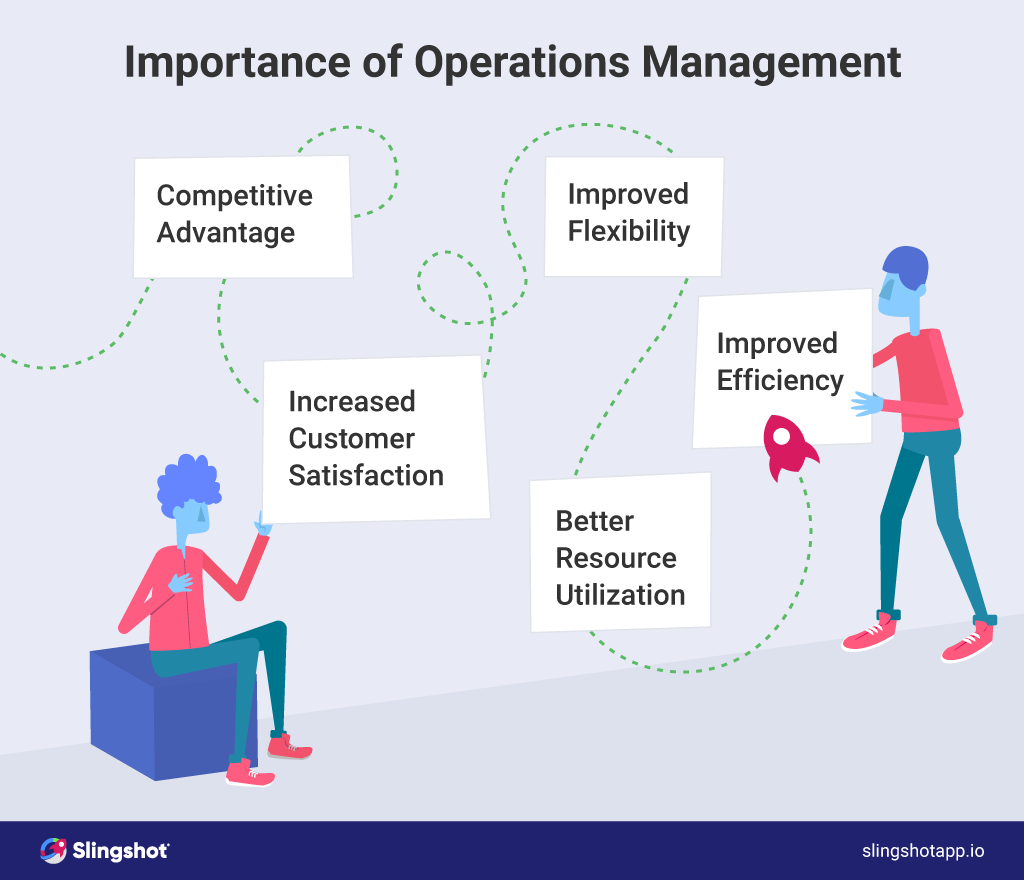
운영 관리란 무엇입니까?
운영 관리는 조직 내 최대 효율성을 보장하기 위해 비즈니스 관행을 관리하고 운영을 명시적으로 관리 및 조정하는 것을 의미합니다. 프로세스에는 제품, 서비스 및 절차의 계획, 설계 및 제어가 포함됩니다.
더 잘 이해하려면 다음을 포함하여 여기에서 다루는 다양한 활동을 살펴보세요.
- 공급망 관리
- 재고 관리
- 프로세스 설계
- 용량 계획
- 품질 관리
- 프로젝트 관리
- 유지보수 및 시설관리
- 린 경영.
운영 관리는 또한 전반적인 고객 경험을 결정하는 데 중요한 역할을 하며 회사가 경쟁 우위를 유지하는 데 도움이 될 수 있습니다. 그렇습니다. 효율적인 운영 관리는 비용 절감, 품질 향상, 수익성 향상을 가져옵니다.
운영 관리가 중요한 이유
운영 관리는 모든 조직의 기본이며 주요 이유는 다음과 같습니다.
효율성이 향상됩니다
이를 잘 사용하면 이러한 관행은 기업이 프로세스를 간소화하고 낭비를 제거하며 리소스를 가장 잘 사용하는 데 도움이 됩니다. 이를 달성하면 효율성과 생산성이 향상되고 회사의 시간과 비용이 절약됩니다.
고객 만족도 향상
효과적인 운영 관리는 기업이 고객의 요구와 기대를 충족하는 제품과 서비스를 제공하는 데 도움이 됩니다. 크고 작은 모든 기업은 고품질 제품과 서비스를 제공함으로써 고객 만족도를 높이고 충성도 높은 고객 기반을 구축할 수 있습니다.
경쟁 우위
운영을 잘 관리하는 기업은 시장에서 경쟁할 수 있는 더 강력한 위치에 있습니다. 수요 변화에 신속하게 대응하고 더 낮은 비용으로 제품과 서비스를 생산할 수 있으며 이는 더 나은 고객 경험을 의미합니다.
더 나은 자원 활용도
효과적으로 리소스를 할당하고 자산을 최대한 활용하는 것은 훌륭해 보이지만 어려울 수 있습니다. 자원을 효과적으로 활용함으로써 기업은 비용을 절감하고 생산량을 늘리며 전반적인 수익성을 향상시킬 수 있습니다.
향상된 유연성
А 잘 관리된 운영 기능을 통해 기업은 변화하는 시장 상황, 고객 요구 및 기술 발전에 적응할 수 있습니다. 그렇게 하면 회사가 앞서 나갈 수 있습니다.
운영 관리 개선
이것을 상상해보세요. 귀하의 생산 라인은 꿈입니다. 고객은 귀하의 제품과 서비스에 대해 열광하고 있습니다. 귀하의 이익은 지붕을 통해 이루어집니다.
마치 동화처럼 들리죠? 꼭 그럴 필요는 없습니다! 운영 관리에 대한 몇 가지 간단한 조정을 통해 비즈니스를 시계처럼 원활하게 작동하는 기계로 바꿀 수 있습니다.
다음 전략을 구현해 보세요.
프로세스 개선
프로세스와 협업을 신속하게 분석하고 관리하여 운영의 낭비와 비효율성을 식별하고 제거하는 방법을 찾으십시오.
기술 도구 수용
프로세스 간소화, 데이터 분석 및 의사 결정 개선, 운영 가시성 향상을 지원하는 기술 솔루션을 구현합니다.
고객 중심
고객은 항상 집중하고 있습니다. 정기적으로 고객 피드백을 수집하고 이를 공유 및 분석하여 제품 및 서비스 개선에 활용함으로써 고객 만족을 최우선으로 삼습니다.
공급망 최적화
공급업체, 제조업체, 유통업체와의 커뮤니케이션, 협업, 조정을 개선하여 공급망을 최적화합니다.
품질 및 위험 관리
일관되고 고품질의 제품과 서비스를 보장하기 위해 강력한 품질 관리 시스템을 구현합니다. 동시에 잠재적인 운영 중단을 완화하고 계획되지 않은 이벤트의 영향을 최소화하기 위한 포괄적인 위험 관리 계획을 개발하는 것이 좋습니다.
지속적으로 운영을 개선하고 고객 만족에 집중함으로써 조직은 경쟁사와 차별화하고 해당 시장에서 경쟁 우위를 확보할 수 있습니다.
운영 관리 프로세스란 무엇이며 어떻게 수행됩니까?
운영 관리를 비즈니스의 쿼터백으로 생각하십시오. 이를 통해 모든 사람이 목표를 달성하기 위해 협력할 수 있습니다. 이제 프로세스를 자세히 살펴보고 팀이 큰 경기에 대비할 수 있는 방법을 보여드리겠습니다.
회사에서 훌륭한 운영 관리를 구축하려면 다음 단계를 완료해야 합니다.
- 계획: 운영 목표를 정의하고 이러한 목표를 달성하는 데 필요한 자원과 조치를 결정합니다.
- 디자인: 계획된 목표를 달성하는 데 도움이 되는 프로세스와 시스템을 만드는 것입니다.
- 실행: 계획과 디자인을 실행에 옮기는 것입니다.
- 모니터링 및 제어: 편차를 식별하고 프로세스가 원활하게 실행되도록 필요한 조정을 수행하기 위한 정기적인 작업 추적입니다.
- 지속적인 개선: 운영을 검토하고 변경하여 효율성과 효율성을 개선합니다.
프로세스는 프로세스 흐름 분석, 용량 계획, 재고 관리, 품질 관리 등 다양한 도구와 기술을 통해 이루어집니다. 또한 모든 운영이 전반적인 목표와 목표에 부합하도록 마케팅, 재무, 인사 등 다른 부서와의 지속적이고 지속적인 협력이 필요합니다.
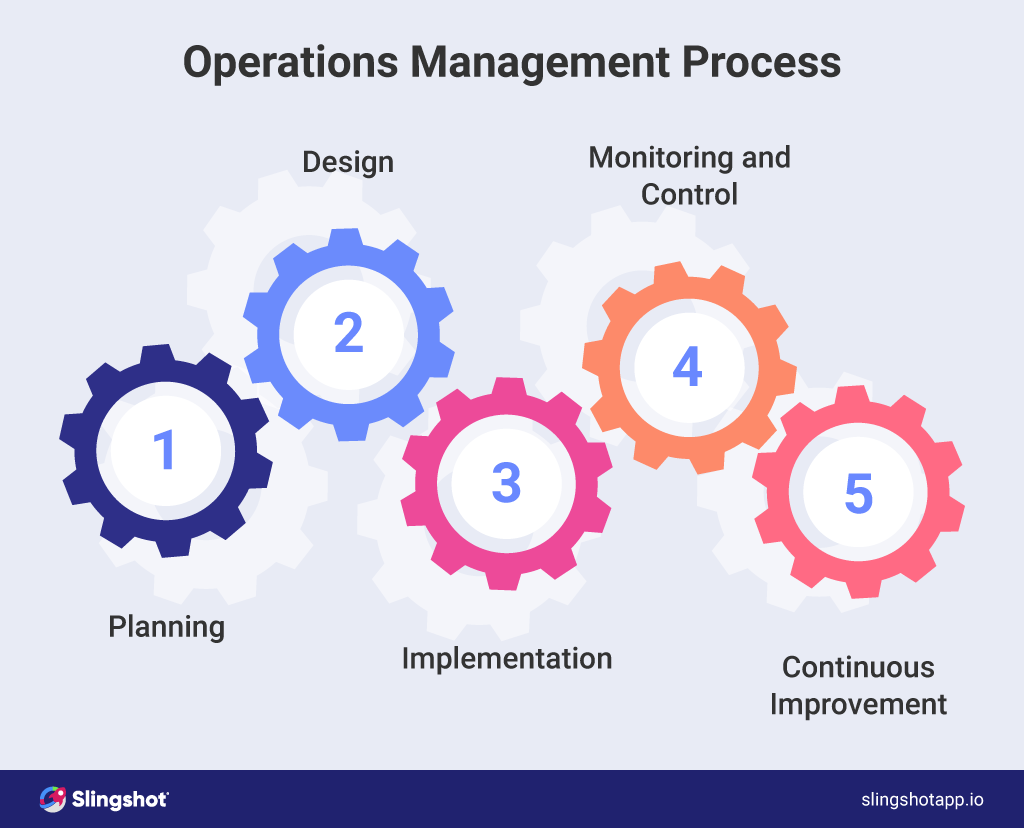
운영 관리 예
Amazon 및 Toyota와 같은 회사가 어떻게 최고 수준의 제품과 서비스를 지속적으로 제공할 수 있는지 궁금한 적이 있습니까? 그 비결은 운영관리에 있습니다. 이들 기업은 프로세스를 간소화하고 리소스를 최대한 활용하는 방법을 찾아내어 시장에서 경쟁 우위를 확보했습니다.
여기 몇 가지 예가 있어요.
- 공급망 관리: 조달, 생산, 유통을 포함하여 공급업체에서 고객까지의 상품 및 서비스 흐름을 감독합니다.
- 재고 관리: 초과 재고 및 관련 비용을 최소화하면서 고객 요구를 충족시키기 위해 적절한 재고 수준을 유지합니다.
- 프로세스 설계: 제품을 생산하거나 서비스를 제공하는 가장 효율적인 방법을 결정합니다.
- 용량 계획: 수요를 충족시키기 위해 적절한 자원(인력, 장비 등)을 선택합니다.
- 품질 관리: 제품 또는 서비스 품질에 대한 표준을 설정하고 성능을 모니터링하여 표준이 충족되었는지 확인하는 것을 포함합니다.
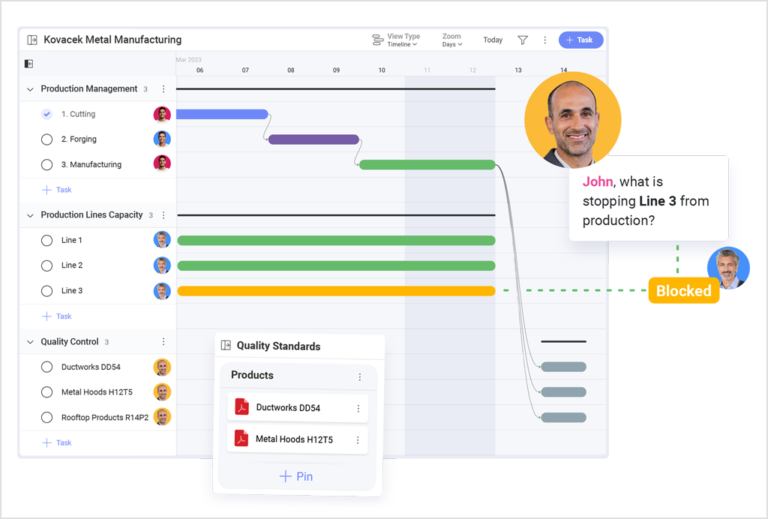
- 프로젝트 관리: 프로젝트 목표와 목표를 달성하기 위해 리소스를 계획, 구성 및 제어하는 작업이 포함됩니다.
- 린(Lean) 관리: 모든 운영에서 낭비를 최소화하고 효율성을 최대화하는 것이 포함됩니다.
이는 다양한 산업과 상황에서 운영 관리의 몇 가지 예일 뿐입니다. 구체적인 초점과 접근 방식은 조직의 규모, 유형, 목표에 따라 크게 달라질 수 있습니다. 많은 기업이 효과적인 운영 관리의 훌륭한 사례가 되고 있습니다. 잘 알려진 예로는 Toyota Motor Corporation, Amazon.com, Coca-Cola 및 McDonald’s가 있습니다.
운영 관리 소프트웨어를 사용해야 하는 이유
운영 관리에 대한 전략을 업데이트하고(물론 개선도) Slingshot과 같은 소프트웨어를 도입해야만 완료할 수 있습니다. 이점은 많고, 의심할 여지 없이 언급할 만한 몇 가지가 있습니다.
작업 간소화
즉시 효율성 향상 - 프로세스를 간소화하면 오류와 중복이 줄어들어 효율성과 생산성이 향상됩니다.
향상된 가시성
올인원 솔루션 도구는 핵심 성과 지표에 대한 실시간 데이터와 통찰력을 제공하여 조직이 정보에 입각한 결정을 내리고 수요 변화에 신속하게 대응할 수 있도록 합니다. 더 나은 방법은 대시보드로 만드는 것입니다(Slingshot 몇 번의 클릭만으로 제공). 여러 소스에서 데이터를 가져옵니다.
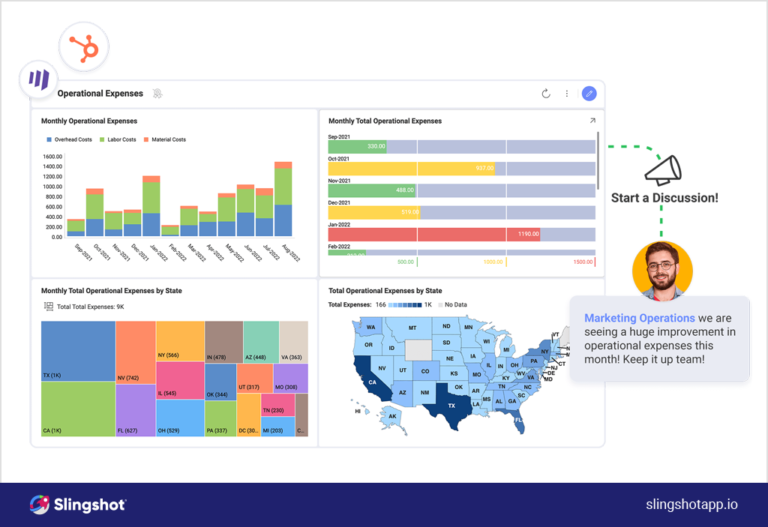
훌륭한 협업
이러한 소프트웨어는 부서와 내부 및 외부 팀 구성원 간의 협업을 촉진하여 이해관계자 조정 및 조정을 향상시킵니다.
올인원 기능
다양한 도구를 전환하여 업무를 수행하는 것을 중단하면 하루 중 더 많은 시간을 확보할 수 있습니다. Slingshot과 같은 올인원 디지털 작업 공간에서 업무를 유지하면 시간을 절약하고 생산성을 높이며 필요한 모든 것을 하나의 앱에서 손쉽게 사용할 수 있습니다.
- 데이터 통찰력
- 채팅
- 작업과 날짜가 있는 프로젝트
- 모든 주요 파일 및 문서
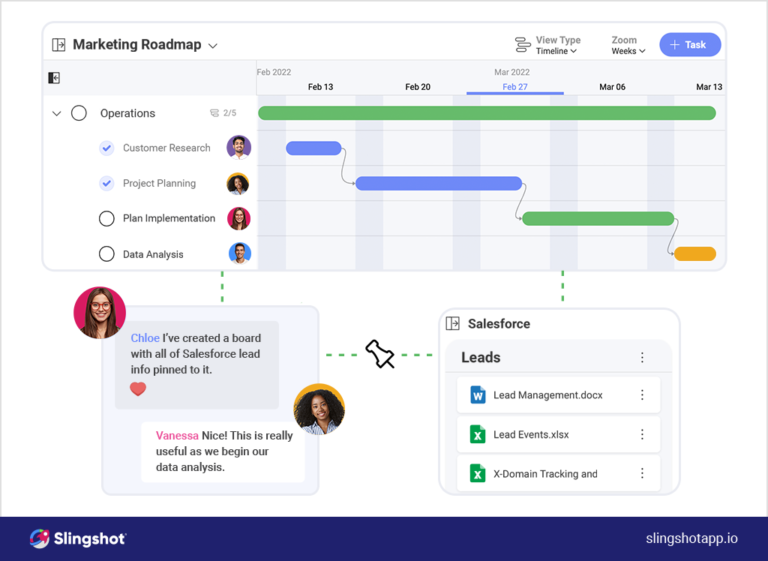
향상된 의사결정
Slingshot과 같은 도구를 사용하면 조직이 운영과 고객 만족도를 개선하는 데이터 중심의 의사 결정을 내릴 수 있도록 공유 가능한 대시보드를 통해 실시간 데이터와 통찰력에 액세스할 수 있습니다.
직접 확인해보려면 지금 바로 Slingshot의 60일 무료 체험판을 시작하세요. 운영 관리자가 감사할 겁니다!







